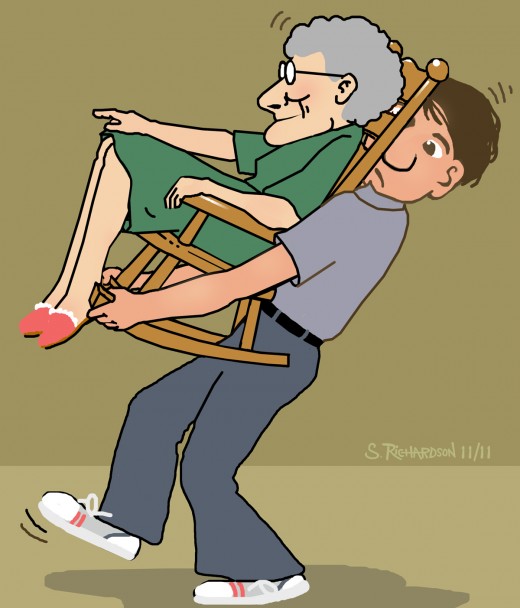Moving Day: Carrying it off with Grace

I remember a certain family in a way that I’m sure they wouldn’t want to be remembered. Luckily, though, they are not relatives or friends, and I haven’t seen them since the incident I’m remembering.
I helped them to move from one house to another.
You may be saying, now, “Well, Sam sure must be a selfish person, if he resents that a family asked him to help them move.”
Know this: that I’ve helped in hundreds of moves, but have not resented my participation in such. So what was the difference? I’ll give you a hint: The most indelibly etched image on my mind for that move was me carrying an open donut box that was almost empty, and had about half a stale donut inside, sitting among crumbs. I carried it, and anything else I could balance in my arms to the moving van.
Here is basically what happened: A family planned on moving on a certain date. They called and asked a few friends and neighbors to help them. I was one of the neighbors. When I showed up in the wee hours of the morning, the house was full of everything a house is capable of collecting in a few years, and in disarray, with an empty moving van outside. I asked where the boxes were, and was told they couldn’t find find very many boxes. I packed the few boxes they had, which did not make a noticeable dent in the goods to be moved. The rest had to be carried out piece-by-piece.
I had to leave early, due to a previous commitment. Those that stayed to the last minute didn’t leave until past midnight. The move had to be continued the next day. I was afraid to ask how long they stayed the second day.
Here are the key issues in this move: 1) There was no sufficient number of boxes. 2) No box had been packed prior to my arrival. 3) There was no hand-truck. 4) At least one of the residents sat on the couch and gave directions. 5) No order had been established in the house, and garbage had not been separated from the goods to be moved. 6) All things in the house were to be moved. 7) There was an inadequate number of vehicles used, or the van was too small. 8) Because there was a minimum number of boxes, the goods could not be stacked very high in the van, so several trips to the new house had to be made. 9) Because of no boxes, not very many goods could be carried out with each trip to the van.
So here’s how you execute a graceful move: First, find beaucup (mucho) boxes, until they’re coming out of your ears. If you can’t buy boxes from the local van rental outlet, you can find sufficient quantities in commercial places that have large dumpsters. Or, some stores will let you remove their extra boxes from the premises. Next, as soon as you know you’re going to move, begin packing boxes. (By the way, don’t put food cans in a big box; be mindful of the backs of your helpers. Clothes and light things go into big boxes.) Of course, you begin with non-perishable items. Do this each day as time permits. Also, clean up and dump anything you can afford to lose. As a shelf is emptied, clean it out, so that you will have one less thing to clean when all is moved. As soon as the new house becomes available -- if it’s before your planned move date, start to pack your car with those packed boxes, and take them over and unload them. The more of this you do, the easier the move will be on those who are gracious enough to help you.
Try to have everything packed before your help arrives, and plan on having a hand-truck or two. At least one hand truck should be capable of moving heavy appliances, and be outfitted with a retaining strap. This will greatly speed up the move, and will help your friends to appreciate you.
If you have a piano, have a professional do it. Although this costs, it will be well worth it, as this way you know you won’t have a broken piano leg, a bunged-up wall, or a few strings that lose their tuning. If you move your piano yourself, you could be spending the “money you saved” on repairs, and on re-tuning it.
Plan to use two groups of people to help you. If you can get ten people to help you move, then usually people will be crawling over each other, and you might not get much done. Also, when someone is planning on how to get that sofa through a narrow stairway with sharp angles, it is the nature of all strong able-bodied men to participate in the strategy of how it’s to be done. Not only that, but others will stop and oversee the whole operation without getting anything else done. Anyway, if a sofa is blocking the stairway, there can be no traffic of people with boxes.
For these reasons, it would be profitable for you to schedule two, or maybe three moving sessions, each being manned by a different group of people -- each group being fewer in number. This way, each person will only spend between two to four hours helping you to move. After you serve them lunch or a fast-food dinner, they will remember your move with fondness (more or less). At least, they won’t resent you, and they’ll think you’re a super hero in planning and moving.
The first group could be dedicated to moving boxes, and the second or last can move the heavier furniture (or the other way around). As for the first group, there shouldn’t be many boxes, as you’ve been moving a carload of boxes once or twice each day before the move. This first group, if there are enough, could form an “assembly line:” Each box can be passed from one to another, so that people don’t have to go around each other or wait for their passage in narrow areas or doorways. This method introduces my next suggestion, which is a way to avoid climbing stairs or the moving van’s ramp:
When you are carrying a box up stairs, or up the ramp that leads to the interior of the moving van or truck, you are not only lifting the weight of the box, but also the weight of your entire body. You can eliminate a great percentage of the work people do, by forming some type of assembly line, or “carrying area.” If you’re carrying things up stairs, you can place two or three people on the stairs, and they can pass the boxes from one to another without them having to lift their bodies up the stairs. There should be a steady stream of boxes, as you’ve already packed them all before your help arrived. But there will always be a lull in this line. So going back and forth a few steps won’t hurt. It will speed up the process, and is better than each person having to climb the full set of stairs. The same goes for the moving van. One person should be inside the van at all times, stacking the boxes or furniture. (The person chosen to do this should be skilled at such. I’ve seen people just put things down on the bed of the truck, never doing much stacking. This wastes the space, and forces multiple trips that wouldn’t otherwise be necessary. As a general rule, heavier things should be to the front (just behind the cab), and on the floor. I often saw a trailer or truck wobbling as it went down the freeway. It was most likely due to weighty objects stacked too high. One of these wobbled so much that it eventually turned over. It was a sad sight to see. If you are ever in this situation, keep a watch on the trailer, or be mindful of any wobbling. If the wobble happens, just remove your foot from the accelerator. Do not brake, as this could cause your vehicle to turn, or your tow to jacknife. Such turning is what caused the trailer I saw to tip over.) If the goods pile up at the gate of the van, then two people can stack until they catch up.
Getting back to the assembly-line method: As people carry goods to the moving van, instead of walking up the ramp, they should place them on the bed of the truck. After putting something down in the truck in this manner, the second person and subsequent helpers should put his/her box on top of the first one, thus helping the one in the truck to not have to bend over so far, which will save on stress, back aches, and energy. The ramp should only be used for things that are carried on the hand trucks. If boxes are carried out on a hand truck, the stack can be left at the back gate of the truck, and another person can lift those into the truck.
If you have cats, and you plan to put new furniture in your new house, you could be breeding a disaster. Cats (especially the more mature ones) grow to love their surroundings or they become more at peace with these objects. If you put them in a new house, and put new furniture there, this could be emotionally damaging to your pets. Try to take with you -- at least for a while -- something they used or slept on regularly. sometimes, cats will try to find their old home, or -- if they can’t -- they will urinate in places or on things that are very inconvenient for you, or behave in other ways that are stressful to you. (I am not an expert in this field; I speak only from experience. You may wish to consult with a professional on this topic if you have at least one cat and you’re planning a move.)
Lastly, and possibly most important, have a meeting with your movers before you start working. Invite them to drink a soda, and offer them cookies, or some other thing that will give you an opportunity to orient them on the move. You may come across as an over-dramatic move fanatic, but at least you might be saving them and yourself some stress, and it could shorten their time with your project. Explain to them all the things I described above. Tell them you’re doing this for them, or anything else that may help them give heed to what you say. If you do not do this, each will employ his/her own method of moving, and this is like matter meeting anti-matter: they will annihilate each other.
Well, there you have it! You probably didn’t know that a manual or guidebook could be written about how to move. But I’ve had plenty of experience in this area, and I’ve learned a few things from it. I now share it all with you. Enjoy.







